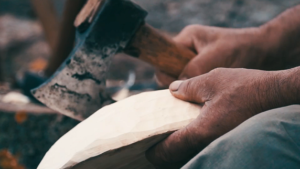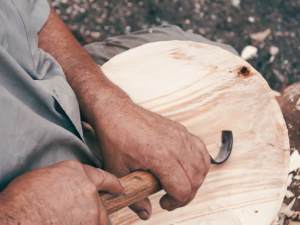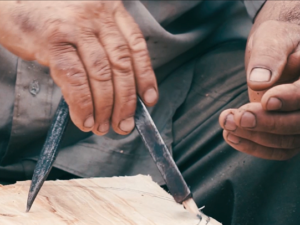 Iordan Gusatu, his wife Stanca Gusatu and their children from Babeni are the aritsans who work with wood in our project. With simple tools they create bowls, stools and plates out of pieces of wood. Their craftship is very impressive.
Iordan Gusatu, his wife Stanca Gusatu and their children from Babeni are the aritsans who work with wood in our project. With simple tools they create bowls, stools and plates out of pieces of wood. Their craftship is very impressive.
 First, the rough outer shape of the object is cut out of a piece of wood with a special hoe. Then the object is hollowed out layer by layer with an adze. At the end, a straight knife and a curved scraper knife are used. These tools give the objects the finishing touch and the unmistakable surface structure. So the surface of the objects always has something of a huge diamond, infinitely sided. These objects clearly differ in their surface structure from turned and other machine-made objects.
First, the rough outer shape of the object is cut out of a piece of wood with a special hoe. Then the object is hollowed out layer by layer with an adze. At the end, a straight knife and a curved scraper knife are used. These tools give the objects the finishing touch and the unmistakable surface structure. So the surface of the objects always has something of a huge diamond, infinitely sided. These objects clearly differ in their surface structure from turned and other machine-made objects.
 Today, as in the past, this traditional handicraft is mastered and practiced by the Rudarii. The Rudari are a group of Roma defined by their craft. Mr. and Mrs. Iordan learned this craft from their parents and grandparents. In the past, the Rudari mostly lived directly on rivers and found the raw material for their craft, the willow, there. A wide variety of objects were made on site and then offered for sale at various village markets.
Today, as in the past, this traditional handicraft is mastered and practiced by the Rudarii. The Rudari are a group of Roma defined by their craft. Mr. and Mrs. Iordan learned this craft from their parents and grandparents. In the past, the Rudari mostly lived directly on rivers and found the raw material for their craft, the willow, there. A wide variety of objects were made on site and then offered for sale at various village markets.
Many Roma define themselves based on traditional handicrafts. The Rudarii work with wood, the Fierarii work with iron, the Caldararii work with copper, the Lautarii were the musicians who played on various occasions, the Lingurarii make wooden spoons, the Hamurarii make bridles for horses, etc. The Romanian ethnologist Oana Burcea has impressively demonstrated the importance of handicrafts for the Romani community in her book “Rromii povestesc = Roma people are sharing their stories” (O. Brucea: Rromii povestesc = Roma people are sharing their stories, Sibiu: Astra Museum, 2015).
On the one hand, communism and the various forced resettlements have severely affected the Roma, who are defined by their handicrafts, and on the other hand, today, after communism, many of their products are no longer sold. This leads to many turning their backs on their craft and a lot of traditional knowledge being lost. How important the traditional craft is for the identity of these people and how there is the necessary stability to prevent further uprooting can be seen when you work with these people on site.
Anyone who would like to take a closer look at the history and social situation of the Roma in Southeast Europe should have a look at the book Arme Roma, Böse Zigeuner by Norbert Mappes-Niediek (N. Mappes-Niediek: Arme Roma, böse Zigeuner, Berlin: Christoph Links Verlag, 2012).

Gefilmt in Babeni. Produziert & editiert in Vienna.
fgruber.com – digital media productions
2018


